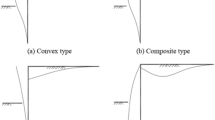Abstract
Currently, the limit equilibrium method of wedge shape is generally adopted for the stability of the excavation surface in shield tunnel construction. In this method, the sliding surface is approximated by a plane, and the lateral friction force of the sliding surface is estimated and assumed to be a known quantity to derive the equilibrium equation and calculate the support force of the excavation surface. However, it is difficult to accurately estimate the lateral friction force of the sliding surface because of many factors that affect such friction, for example, soil arching. In this paper, a sliding block model of curved surface body composed of a semicircular platform and a partial sphere is proposed for the stability of the excavation surface in shield tunnel construction. By using the symmetry of the surface body model, there is no need for estimating the friction force of the sliding surface during the stability analysis of the excavation surface, and the calculation accuracy of the limit support pressure is improved. Furthermore, the force analysis of the semi-circular platform surface model above the tunnel vault is carried out. Considering the variation of the lateral pressure coefficient caused by the deflection of the principal stress under the soil arch effect, the analytical solution of the vertical stress in the soil is derived when the sliding crack surface is curved. Finally, we present a sensitivity analysis of various parameters affecting the support force of the excavation face through the study of examples. The influencing factors and changing rules related to the support force of the excavation face are also discussed.
Similar content being viewed by others
References
Anaunostou G (2012) The contribution of horizontal arching to tunncl face stability. Geotcchnik 2012 35(1):34–44, DOI: https://doi.org/10.1002/gete.201100024
Broms BB, Bennermark H (1967) Stability of clay at vertical openings. Journal of Soil Mechanics and Foundation Engineering Division 93(1):71–94, DOI: https://doi.org/10.1061/JSFEAQ.0000946
Chen RP, Tang LJ, Yin XS (2015) An improved 3D wedge-prism model for the face stability analysis of the shield tunnel in cohesionless soils. Acta Geotechnica, 2015 10(5):683–692, DOI: https://doi.org/10.1007/s11440-014-0304-5
Cui XP (2021) Study on shield tunnel support based on three-dimensional bucket soil arch, Hebei University of Engineering, Handan, China
Davis EH, Gunn MJ, Mair RJ, Seneviratne HN (1980) The stability of shallow tunnels and underground openings in cohesive material. Géotechnique 30(4):397–416, DOI: https://doi.org/10.1680/geot.1980.30.4.397
Dong XW (2020) Stability analysis on shield across the excavation section. Track Traffic & Underground Engineering 38(4):153–157
Horn M (1961) Horizontal earth pressure on perpendicular tunnel face, Hungarian National Conference of the Foundation Engineer Industry. Budapest 7–16 (in Hungarian)
Hu XY (2010) Study on face stability and its failure mechanism for large slurry shield-driven tunnel in complex ground condition-couplin macroscopic aspect. Tongji University, Shanghai, China
Li CL (2014) Method for calculating loosening earth pressure during construction of shield tunnels. Chinese Journal of Geotechnical Engineering 36(9):1714–1720, DOI: https://doi.org/10.11779/CJGE201409019
Liu KQ, Ding WT, CHen R, Hou ML (2020) Construction of three-dimensional failure model of shield tunnel face and calculation of the limit supporting force. Rock and Soil Mechanics 41(7):2293–2303,2469, DOI: https://doi.org/10.16285/j.rsm.2019.1412
Lv XL, Zhou YC, Huang MS, Zeng S (2018) Experimental study of the face stability of shield tunnel in sands under seepage condition. Tunnelling and Underground Space Technology, 2018 74:195–205, DOI: https://doi.org/10.1016/j.tust.2018.01.015
MIU LC, WANG ZX, SHI WB (2015) Theoretical and numerical simulations of face stability around shield tunnels in sand. Chinese Journal of Geotechnical Engineering 37(1):98–104, DOI: https://doi.org/10.11779/CJGE201501011
Mollon G, Dias D, Soubra A-H (2010) Face stability analysis of circular tunnels driven by a pressurized shield. Journal of Geotechnical and Geoenvironmental Engineering, 2010 136(1):215–229, DOI: https://doi.org/10.1061/(asce)gt.1943-5606.0000194
Mollon G, Dias D, Soubra A-H (2011) Rotational failure mechanisms for the face stability analysis of tunnels driven by a pressurized shield. International Journal for Numerical and Analytical Methods in Geomechanics 2011, 35(12):1363–1388, DOI: https://doi.org/10.1002/nag.962
Mollon G, Dias D, Soubra A-Hm (2013) Continuous velocity fields for collapse and blowout of a pressurized tunnel face in purely cohesive soil. International Journal for Numerical and Analytical Methods in Geomechanics, 2013 37(13):2061–2083, DOI: https://doi.org/10.1002/nag.2121
Qin JS (2005) Study on faee deformation and collapse of earth pressure shield tunnel. Hohai University, Nanjing, China
Soubra AH, ASCE M, Dias D, ASCE M, Emeriault F, Kastner R (2008) Three-dimensional face stability analysis of circular tunnels by a kinematical approach. Proceedings of the GeoCongress, Characterization, Monitoring, and Modelling of Geosystems, 9–12, 2008, USA New Orleans, DOI: https://doi.org/10.1061/40972(311)112
Sterpi D, Cividini A, Sakurai A, Nishitake S (1996) Laboratory model tests and numerical analysis of shallow tunnels. ISRM International Symposium—EUROCK 96, 1996
Subrin D, Wong H (2002) Tunnel face stability in frictional material: A new 3D failure mechanism. Comptes Rendus Mecanique, 2002 330(7):513–519
Wei G (2005) Theoertieal study on porperties of soil and sturcture during pipe jacking construction. Zhejiang University, Hanzhou, China
Xu QW, Tang ZH, Zhu HH, Wang GF, Lu LH (2017) Limit support pressure at excavation face of shield tunnels. Chinese Journal of Geotechnical Engineering 39(7):1234–1240, DOI: https://doi.org/10.11779/CJGE201707009
Zhang CP, Li W, Zhu WJ, Zhu WJ, Tan ZB (2020) Face stability analysis of a shallow horseshoe-shaped shield tunnel in clay with a linearly increasing shear strength with depth. Tunnelling and Underground Space Technology, 2020 97:103291, DOI: https://doi.org/10.1016/j.tust.2020.103291
Zhao W, Cheng C, Li SG, Xu H, Zhu L (2017) Analysis and improvement of wedge supporting pressure model of shield tunnel excavation face. China J. Highw. Transp 30(8):74–81, DOI: https://doi.org/10.19721/j.cnki.1001-7372.2017.08.008
Acknowledgments
This paper was supported by Anhui Provincial Natural Science Foundation (Grant No. 1808085ME162), the Excellent Top Talents Training Program of Anhui Provincial Colleges and Universities (No.gxbjZD2022068) and Tongling University Foundation for Leaders of Disciplines in Science, China (No. 2020tlxyxs19). The author wishes to express his gratitude for the support given to this work.
Author information
Authors and Affiliations
Corresponding author
Rights and permissions
About this article
Cite this article
Li, Cl. Stability Analysis of Shield Excavation Surface with Curved Body Model. KSCE J Civ Eng 26, 5342–5352 (2022). https://doi.org/10.1007/s12205-022-0068-7
Received:
Accepted:
Published:
Issue Date:
DOI: https://doi.org/10.1007/s12205-022-0068-7



